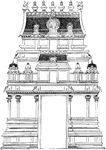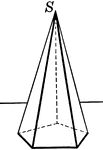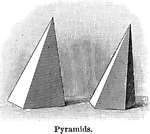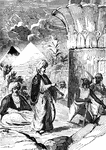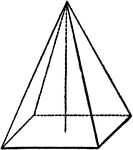
Pryamid
"A pyramid is a solid whose base is a polygon, and whose sides are triangles uniting at a common point,…
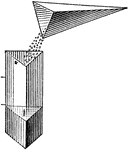
Comparative Volumes Of A Pyramid And Prism
Illustration used to compare the volumes of a pyramid and a prism by emptying sand from the pyramid…

Pyramid Pruning
"a shows a young tree with its second year's growth, the upright shoot of the maiden tree having been…
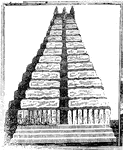
Ancient Pyramid
"The pyramids of Egypt are well entitled to a place among the most interesting curiosities in the world.…
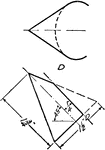
Development Exercise of Oblique Hexagonal Pyramid
A sample exercise problem to complete the top part and create a stretched out image of the oblique hexagonal…

Development Exercise of Pentagonal Pyramid
The problem exercise in completing the top view and creating the development, or rolled out, image of…
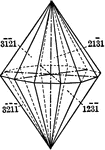
Dihexagonal pyramid
"The dihexagonal pyramid is a form of twenty-four isoceles triangular faces, each of which intersects…

Ditetragonal pyramid
"The ditetragonal pyramid is a form composed of sixteen isoceles trianglular faces, each of which intersects…
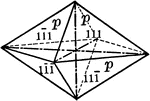
First order pyramid
"The pyramid of the first order is a form consisting of eight isoceles triangular faces, each of which…

Frustum Pyramid
The frustum of a pyramid is the portion of a pyramid included between the base and a section parallel…

Frustum Pyramid for Volume
The volume of the frustum of any pyramid is equal to the sum of the volumes of three pyramids whose…
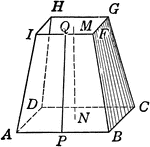
Pyramid Frustum
An illustration of a pyramid with the top cut off by a plane parallel to the base. The remaining part…
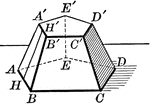
Frustum of a Regular Pyramid With Pentagonal Base
Illustration of a regular pyramid with a pentagon for a base.
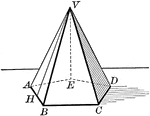
Frustum of Pentagonal Pyramid
The frustum of a pentagonal pyramid is the portion of a pyramid included between the base and a section…

Hexagonal Pyramid
Illustration of a right hexagonal pyramid with hidden edges shown. The base is a hexagon and the faces…
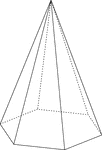
Hexagonal Pyramid
Illustration of a right hexagonal pyramid with hidden edges shown. The base is a hexagon and the faces…
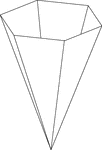
Inverted Hexagonal Pyramid
Illustration of a hollow right hexagonal pyramid. The base is a hexagon and the faces are isosceles…

Inverted Nonagonal Pyramid
Illustration of a hollow right nonagonal pyramid. The base is a nonagon and the faces are isosceles…
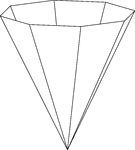
Inverted Octagonal Pyramid
Illustration of a hollow right octagonal pyramid. The base is an octagon and the faces are isosceles…

Inverted Rectangular Pyramid
Illustration of a hollow right rectangular pyramid. The base is a rectangle and the faces are isosceles…
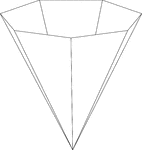
Inverted Septagonal/Heptagonal Pyramid
Illustration of a hollow right heptagonal (septagonal) pyramid. The base is a heptagon and the faces…
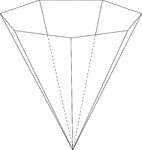
Inverted Septagonal/Heptagonal Pyramid
Illustration of a hollow right heptagonal (septagonal) pyramid. The base is a heptagon and the faces…

Nonagonal Pyramid
Illustration of a right nonagonal pyramid with hidden edges shown. The base is a nonagon and the faces…
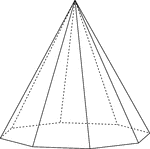
Octagonal Pyramid
Illustration of a right octagonal pyramid with hidden edges shown. The base is an octagon and the faces…

Pentagonal Pyramid
Illustration of a right pentagonal pyramid with hidden edges shown. The base is an pentagon and the…
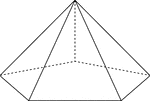
Pentagonal Pyramid
Illustration of a right pentagonal pyramid with hidden edges shown. The base is an pentagon and the…
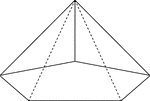
Pentagonal Pyramid
Illustration of a right pentagonal pyramid viewed from below with hidden edges shown. The base is an…
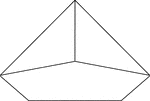
Pentagonal Pyramid
Illustration of a right pentagonal pyramid viewed from below. The base is an pentagon and the faces…

Pentagonal Pyramid For Volume
Illustration of pentagonal pyramid used to show that the volume is equal to one third of the product…
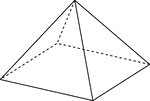
Rectangular Pyramid
Illustration of a right rectangular pyramid with hidden edges shown. The base is a rectangle and the…

Rectangular Pyramid
Illustration of a right rectangular pyramid with hidden edges shown. The base is a rectangle and the…
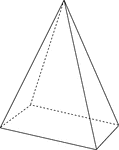
Rectangular Pyramid
Illustration of a right rectangular pyramid with hidden edges shown. The base is a rectangle and the…
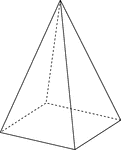
Rectangular Pyramid
Illustration of a right rectangular pyramid with hidden edges shown. The base is a rectangle and the…

Second order pyramid
"The pyramid of the second order is a form composed of eight isoceles triangular faces, each of which…

Septagonal/Heptagonal Pyramid
Illustration of a right septagonal/heptagonal pyramid with hidden edges shown. The base is a heptagon…

Skewed Hexagonal Pyramid
Illustration of a non-right, or skewed, hexagonal pyramid with hidden edges shown. The base is a hexagon…

Skewed Rectangular Pyramid
Illustration of a non-right, or skewed, rectangular pyramid with hidden edges shown. The base is a rectangle…

Triangular Pyramid For Volume
Illustration of triangular pyramid used to show that the volume is the limit of the sum of the volumes…
Triangular Pyramid For Volume
Illustration of triangular pyramid used to show that the volume is equal to one third of the product…

Pyramids
An illustration of two pyramids. A pyramid is a building where the upper surfaces are triangular and…

2 Right Pentagonal Pyramids
Illustration of 2 right pentagonal pyramids with hidden edges shown. The pentagonal bases are congruent,…
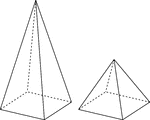
2 Right Rectangular Pyramids
Illustration of 2 right rectangular pyramids with hidden edges shown. The rectangular bases are congruent,…

Equivalent Triangular Pyramids
Two triangular pyramids having equivalent bases and equal altitudes are equivalent.

Pyramids With Pentagonal and Triangular Bases
Illustration of pentagonal and triangular pyramids cut by a plane parallel to the bases.
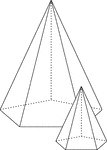
Similar Pentagonal Pyramids
Illustration of 2 similar right pentagonal pyramids with hidden edges shown. The height of the pyramid…

Triangular Pyramids for Volume
Illustration showing that the volume of 2 triangular pyramids, having the same trihedral angle of the…

Quartz
"Terminated usually by a combination of a positive and negative rhombohedron, which often are so equally…

Rectangular Pyramid Cut By Plane
Illustration of a right rectangular pyramid that has been cut by a plane parallel to the base. The lower…
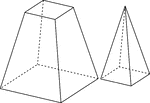
Rectangular Pyramid Cut By Plane
Illustration of a right rectangular pyramid that has been cut by a plane parallel to the base. The top…

Rectangular Pyramid Cut By Plane
Illustration of a right rectangular pyramid that has been cut by a plane parallel to the base. The top…


